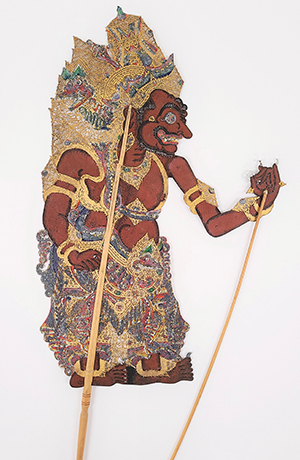Balinese Shadow Puppet

Shadow puppet plays are popular throughout Indonesia. In Bali, leather puppets like this one, called wayang kulit, are used for both entertainment and sacred ritual. During nighttime performances, the puppets’ shadows are cast against a white cloth stretched on bamboo and lit by an oil lamp above the puppeteer’s head. Puppeteers, known as dalangs, prefer a coconut-oil lamp over an electric bulb because the flickering flame enhances the motions of the puppets. For the dalang, who sometimes serves as a priest, each performance is a mix of artistic skill and religious knowledge. A single dalang moves the puppets, provides the voices, and even provides sound effects with a small hammer held by their foot. They also cue the musicians and improvise jokes with the audience—all while portraying the plays’ philosophical meaning.
This puppet represents Dasamuka, the king of demons and the main antagonist in the Ramayana, an ancient Hindu epic frequently reenacted through wayang performances. The Ramayana tells the story of tells the story of Rama, an ancient king, and his wife, Sita. The story follows Rama as he saves Sita from being kidnapped by Dasamuka with the help of Hanuman the monkey king. There are many subplots and diversions in its nearly 24,000 verses, but the Ramayana and other shadow puppet performances serve as more than just amusing tales – they are lessons about Hindu practices. The hero characters are portrayed as models for correct behavior. Although Indonesia is a Muslim majority country, on the island of Bali, nearly 90 percent of the population identify as Hindu.
This puppet is currently on display in Balinese Offerings, on exhibit through April 22, 2023.
